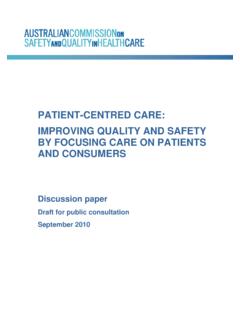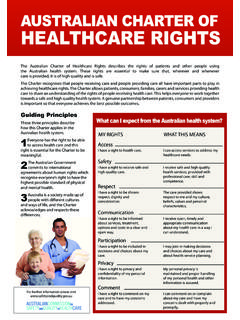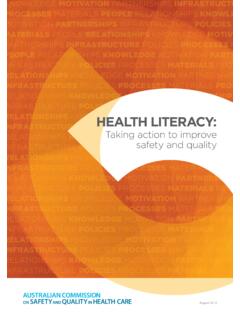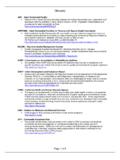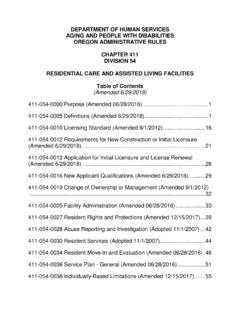Transcription of Preventing Falls and Harm From Falls in Older People
1 Preventing Fallsand harm From Falls in Older PeopleBest Practice Guidelines for Australian residential Aged care Facilities2009 ISBN: 978-0-9806298-2-8 Commonwealth of Australia 2009 This work is copyright. It may be reproduced in whole or part for study or training purposes subject to the inclusion of an acknowledgment of the source. Reproduction for purposes other than those indicated above requires the written permission of the Australian Commission on Safety and Quality in Health care (ACSQHC).ACSQHC was established in January 2006 by the Australian health ministers to lead and coordinate improvements in safety and quality in Australian health of this document and further information on the work of ACSQHC can be found at or from the Office of the Australian Commission on Safety and Quality in Health care on telephone: +61 2 9263 3633 or email to: resources available from : Preventing Falls and harm From Falls in Older People : Best Practice Guidelines for Australian Community care 2009 Guidebook to Preventing Falls and harm From Falls in Older People : Best Practice Guidelines for Australian Community care 2009 Preventing Falls and harm From Falls in Older People .
2 Best Practice Guidelines for Australian Hospitals 2009 Guidebook to Preventing Falls and harm From Falls in Older People : Best Practice Guidelines for Australian Hospitals 2009 Guidebook to Preventing Falls and harm From Falls in Older People : Best Practice Guidelines for Australian residential Aged care Facilities 2009 Implementation Guide for Preventing Falls and harm From Falls in Older People : Best Practice Guidelines for Australian Hospitals and residential Aged care Facilities 2009 Fact sheets Falls facts for residents and carers Falls facts for doctors Falls facts for nurses Falls facts for allied health professionals Falls facts for support staff (cleaners, food services and transport staff) Falls facts for health managersAustralians today enjoy a longer life expectancy than previous generations, but for some this is disrupted by Falls .
3 As we age, our sure-footedness declines and, at the same time, our bones become increasingly brittle. The comment that he fell and broke his hip is heard all too often in fact, almost one in three Older Australians will suffer a fall each year. Such Falls can have extremely serious consequences, including significant disability and even are one of the largest causes of harm in care . Preventing Falls and minimising their harmful effects are critical. During care episodes, Older People are usually going through a period of intercurrent illness, with the resultant frailty and the uncertainty that brings. They are at their most vulnerable, often in unfamiliar settings, and accordingly attention has been paid to acquiring evidence about what can be done to minimise the occurrence of Falls and their harmful effects, and to use these data in the national Falls new guidelines consider the evidence and recommend actions in the three main care settings: the community, hospitals and residential aged care facilities.
4 Each of three separate volumes addresses one of these care settings, providing guidance on managing the various risk factors that make Older Australians in care vulnerable to Australian Commission on Safety and Quality in Health care is charged with leading and coordinating improvements in the safety and quality of health care for all Australians. These new guidelines are an important part of that ongoing commitment of staff in community, hospital and residential aged care settings is critical in Falls prevention. I commend these guidelines to Chris Baggoley Chief Executive Australian Commission on Safety and Quality in Health care August 2009 Statement from the chief executiveivPreventing Falls and harm From Falls in Older People v Contents PageStatement from the chief executive iiiAcronyms xiiiPreface xvAcknowledgments xviiSummary of recommendations and good practice points xixPart A Introduction 11 Background About the guidelines Scope of the guidelines Targeting Older Australians Specific to Australian residential aged care facilities Relevant to all residential aged care facility staff Terminology Definition of a fall Definition of an injurious fall Definition of assessment and risk assessment Definition of interventions Definition
5 Of evidence Development of the guidelines Expert advisory group Review methods Levels of evidence Consultation Governance of the review of the Australian Falls Guidelines How to use the guidelines Overview How the guidelines are presented 102 Falls and Falls injuries in Australia Incidence of Falls fall rates in Older People Impact of Falls Cost of Falls Economic considerations in Falls prevention programs Characteristics of Falls Risk factors for falling 153 Involving residents in Falls prevention 17viPreventing Falls and harm From Falls in Older People Part B Standard Falls prevention strategies 194 Falls prevention interventions Background and evidence Choosing Falls prevention interventions Multifactorial interventions Single interventions Special considerations Cognitive impairment Rural and remote settings Indigenous and culturally and linguistically diverse groups Economic evaluation 245 Falls risk screening and assessment Background and evidence Falls risk screening Falls risk assessment Principles of care Falls risk screening Falls risk assessment Special considerations Cognitive impairment Rural and remote settings Indigenous and culturally and linguistically diverse groups People with limited mobility 31 Part C Management strategies for common Falls risk factors 336 Balance and mobility limitations Background and evidence Risk factors for falling Improving balance and mobility with exercise Exercise for
6 Preventing Falls Exercise as part of a multifactorial intervention Principles of care Assessing balance, mobility and strength Special considerations Cognitive impairment Rural and remote settings Indigenous and culturally and linguistically diverse groups Economic evaluation 44 PageviiContents 7 Cognitive impairment Background and evidence Cognitive impairment associated with increased Falls risk Cognitive impairment and Falls prevention Principles of care Assessing cognitive impairment Providing interventions Special considerations Indigenous and culturally and linguistically diverse groups Economic evaluation 508 Continence Background and evidence Incontinence associated with increased Falls risk Incontinence and Falls interventions in residential aged care facilities Principles of care Screening continence
7 Providing strategies to promote continence Special considerations Cognitive impairment Rural and remote settings Indigenous and culturally and linguistically diverse groups Economic evaluation 569 Feet and footwear Background and evidence Footwear associated with increased Falls risk Foot problems Principles of care Assessing feet and footwear Improving foot condition and footwear Special considerations Cognitive impairment Rural and remote settings Indigenous and culturally and linguistically diverse groups Economic evaluation 62 PageviiiPreventing Falls and harm From Falls in Older People 10 Syncope Background and evidence Vasovagal syncope Orthostatic hypotension (postural hypotension) Carotid sinus hypersensitivity Cardiac arrhythmias Principles of care Special considerations Cognitive impairment Economic evaluation 6611 Dizziness and vertigo Background and evidence Vestibular disorders associated with an increased risk of falling Principles of care Assessing vestibular function Choosing interventions to reduce symptoms of dizziness Special considerations Economic evaluation 7012 Medications Background and evidence Medication use and increased Falls risk Evidence for interventions Principles of care Reviewing medications Providing interventions Special considerations Cognitive impairment Rural and remote settings Economic evaluation 7513 Vision Background and evidence Visual functions
8 Associated with increased Falls risk Eye diseases associated with an increased risk of falling Principles of care Screening vision Providing interventions Special considerations Cognitive impairment Rural and remote settings Indigenous and culturally and linguistically diverse groups People with limited mobility Economic evaluation 85 Pageix Contents 14 Environmental considerations Background and evidence Principles of care Assessing the resident in their environment Designing multifactorial interventions that include environmental modifications Conducting environmental reviews Orientating new residents Incorporating capital works planning and design Providing storage and equipment Review and monitoring Special considerations Cognitive impairment Rural and remote settings Nonambulatory People People who wander Economic evaluation 9215 Individual surveillance and observation Background and evidence Principles of care Flagging Colours for stickers and bedside notices Sitter programs Response systems Review and monitoring Special considerations Cognitive impairment Indigenous and culturally and linguistically diverse groups Economic evaluation 9716 Restraints Background and evidence Principles of care Assessing the need for restraints and considering alternatives Using restraints Review and monitoring Special considerations Cognitive impairment Economic evaluation 102 PagexPreventing Falls and harm From Falls in Older
9 People Part D Minimising injuries from Falls 10517 Hip protectors Background and evidence Studies on hip protector use Types of hip protectors How hip protectors work Adherence with use of hip protectors Principles of care Assessing the need for hip protectors Using hip protectors at night Cost of hip protectors Training in hip protector use Review and monitoring Special considerations Cognitive impairment Indigenous and culturally and linguistically diverse groups Climate Economic evaluation 11218 Vitamin D and calcium supplementation Background and evidence Vitamin D supplementation alone Vitamin D combined with calcium supplementation Vitamin D and sunlight Toxicity and dose Principles of care Assess adequacy of vitamin D Ensure minimum sun exposure to prevent vitamin D deficiency Consider vitamin D and calcium supplementation Encourage residents to include foods high in calcium in their diet Discourage residents from consuming foods that prevent calcium absorption Special considerations Cognitive impairment Indigenous and culturally and linguistically diverse groups Economic evaluation 11919 Osteoporosis management Background and evidence Falls and fractures Diagnosing osteoporosis Interventions for Falls and Falls -related injuries relevant to osteoporosis Osteoporosis in residential aged care Principles of care Review and monitoring Special considerations Cognitive impairment Economic evaluation 124 Pagexi
10 Contents Part E Responding to Falls 12720 Post- fall management Background and evidence Responding to incidents Post- fall follow-up Analysing the fall Reporti
